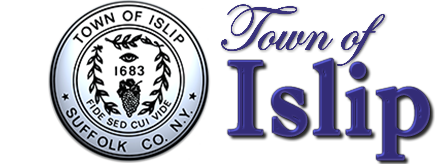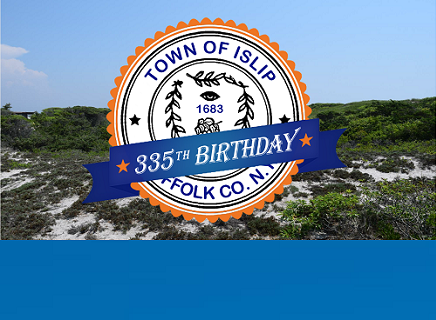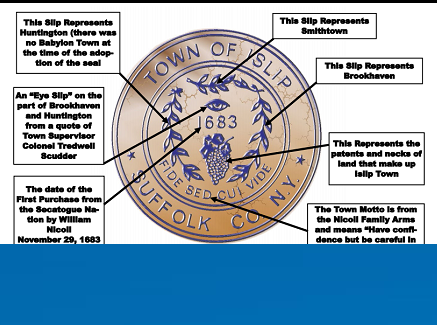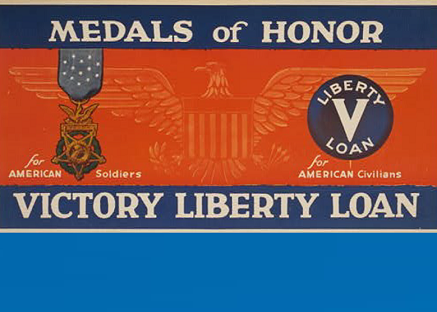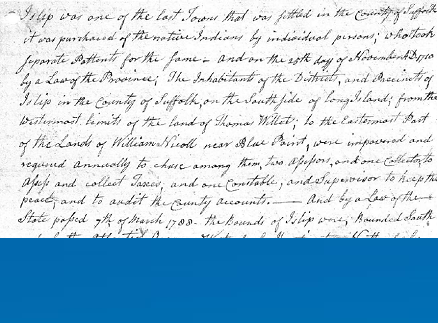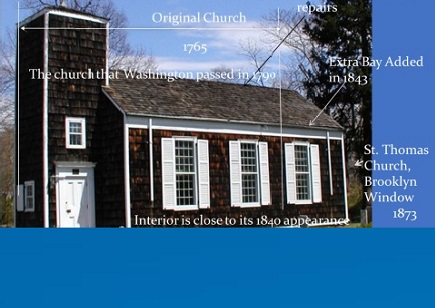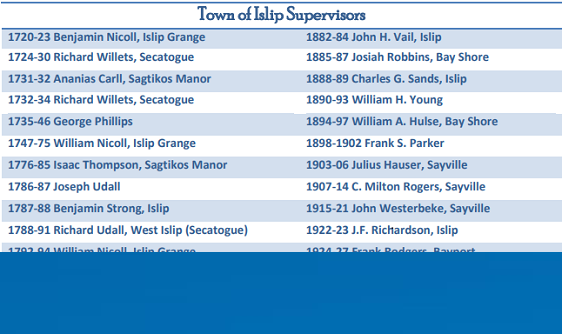For centuries, the Algonquin Indians inhabited Long Island. A sub-division of the Algonquins known as the Secatogues occupied all of the area in the Town of Islip. Their principal villages were at West Islip (Secatogue), Bay Shore (Penataquit) and Oakdale (Connetquot).
On November 29, 1683, William Nicoll became the first patentee of Islip when he purchased land from Sachem (Chief) Winnequaheagh of Connetquot. He named his 50,000- acre plantation Islip Grange, in honor of the town from which he emigrated: Islip, England. The original settlement encompassed Bayport, Bohemia, Brentwood, Central Islip, East Islip, Great River, Hauppauge, Holbrook, Holtsville, Islip Terrace, Oakdale, Sayville, West Sayville, and part of Ronkonkoma. Part of Nicoll’s original domain is now the site of Heckscher State Park. Other early land patentees were Andrew Gibb (Islip), John Mowbray (Bay Shore), Stephanis Van Cortlandt (Sagtikos Manor) and Richard and Thomas Willets (West Islip).
Read more . . .
In 1710, the precinct (or district) of Islip was established and in 1720, the first elections were held for the posts of supervisor, constable, collector and two assessors. The Town Clerk’s records of the annual meetings typically began, “At the Annual Meeting of the freeholders of the precinct of Islip ...”. The entry for the first Tuesday of April 1790, marked the first in which Islip was referred to as a “Town.”
Some early setters made their living raising grain and beef, but Islip’s proximity to the water made fishing and shipping the principal way of life. Jacob Ockers, whose Oakdale home on Montauk Highway is the only town-owned structure listed on the National Register of Historic Places, was known as the “Oyster King” at the turn of the century. A Dutch immigrant, Ockers parlayed his limited fishing experience into a world-renowned industry. By 1900, his Blue Point Oyster Company shipped as many as 100,000 barrels of oysters a year all over the world. In 1908, New York State passed a law forbidding any oysters to be called “Bluepoints” unless they came from the Great South Bay. The clam and oyster industry employed 500 boats and 1,100 men locally, and oyster shells were used to pave town streets until around 1915.
The Great South Bay also attracted wealthy tourists from New York City who built mansions, lodges and country clubs for their vacationing pleasure, several of which still stand today. Islip’s oldest deeded home, and site of an overnight stay by George Washington, is Sagtikos Manor in West Bay Shore. William Nicoll had St. John’s Episcopal Church in Oakdale built in 1765, so that early settlers and Native Americans who had become Christians had a place to worship. It is the oldest church still in active use on the South Shore.
William K. Vanderbilt’s estate is now the site of Dowling College in Oakdale. He commissioned the construction of St. Mark’s Episcopal Church in Islip (Montauk Highway) when his daughter announced her engagement. The estate of Commodore Bourne, founder of the Singer Sewing Machine Company, in Oakdale, is now the site of St. John’s University. The original South Side Sportsmen’s Club lodge still stands amid the beautiful grounds of Connetquot River State Park Preserve. This stately and important architectural structure is said to be what first attracted many of the noted personalities to the area.
By 1826 the federal government had erected the first Fire Island lighthouse. By the 1860s, David Sammis's Surf Hotel, located just east of the lighthouse, attracted hundreds of guests who arrived from New York City and the mainland by ferry, private boats and chartered sloops. To this day it remains the largest hotel ever built on Fire Island. The hotel industry was important to Islip’s economy throughout the 19th Century and for a good part of the 20th Century.
In the early years, the town expanded slowly. The population was 1,156 in 1820; 1,653 in 1830; 1,909 in 1840 and 2,602 in 1850.
In 1844, the Long Island Railroad came to Islip Town. In 1868, the South Side Railroad was constructed to serve the hamlets on the bay and the area flourished. There was a flurry of building after World War I, but nothing like the population explosion and land development following World War II. Islip’s population exploded from 71,00 in 1950 to 278,000 in 1970.
Over the course of Islip’s heritage, it has changed from a subsistence farming economy in the early years, to a bustling fishing and tourism area in the 19th and 20th Centuries, to the “bedroom community” of the post World War II years, to its status today as a leader, where industry and community, providing a great place for its more than 300,000 residents to live, work and play.
Some early setters made their living raising grain and beef, but Islip’s proximity to the water made fishing and shipping the principal way of life. Jacob Ockers, whose Oakdale home on Montauk Highway is the only town-owned structure listed on the National Register of Historic Places, was known as the “Oyster King” at the turn of the century. A Dutch immigrant, Ockers parlayed his limited fishing experience into a world-renowned industry. By 1900, his Blue Point Oyster Company shipped as many as 100,000 barrels of oysters a year all over the world. In 1908, New York State passed a law forbidding any oysters to be called “Bluepoints” unless they came from the Great South Bay. The clam and oyster industry employed 500 boats and 1,100 men locally, and oyster shells were used to pave town streets until around 1915.
The Great South Bay also attracted wealthy tourists from New York City who built mansions, lodges and country clubs for their vacationing pleasure, several of which still stand today. Islip’s oldest deeded home, and site of an overnight stay by George Washington, is Sagtikos Manor in West Bay Shore. William Nicoll had St. John’s Episcopal Church in Oakdale built in 1765, so that early settlers and Native Americans who had become Christians had a place to worship. It is the oldest church still in active use on the South Shore.
William K. Vanderbilt’s estate is now the site of Dowling College in Oakdale. He commissioned the construction of St. Mark’s Episcopal Church in Islip (Montauk Highway) when his daughter announced her engagement. The estate of Commodore Bourne, founder of the Singer Sewing Machine Company, in Oakdale, is now the site of St. John’s University. The original South Side Sportsmen’s Club lodge still stands amid the beautiful grounds of Connetquot River State Park Preserve. This stately and important architectural structure is said to be what first attracted many of the noted personalities to the area.
By 1826 the federal government had erected the first Fire Island lighthouse. By the 1860s, David Sammis's Surf Hotel, located just east of the lighthouse, attracted hundreds of guests who arrived from New York City and the mainland by ferry, private boats and chartered sloops. To this day it remains the largest hotel ever built on Fire Island. The hotel industry was important to Islip’s economy throughout the 19th Century and for a good part of the 20th Century.
In the early years, the town expanded slowly. The population was 1,156 in 1820; 1,653 in 1830; 1,909 in 1840 and 2,602 in 1850.
In 1844, the Long Island Railroad came to Islip Town. In 1868, the South Side Railroad was constructed to serve the hamlets on the bay and the area flourished. There was a flurry of building after World War I, but nothing like the population explosion and land development following World War II. Islip’s population exploded from 71,00 in 1950 to 278,000 in 1970.
Over the course of Islip’s heritage, it has changed from a subsistence farming economy in the early years, to a bustling fishing and tourism area in the 19th and 20th Centuries, to the “bedroom community” of the post World War II years, to its status today as a leader, where industry and community, providing a great place for its more than 300,000 residents to live, work and play.
